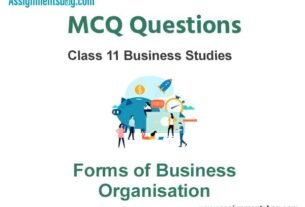Please refer to MCQ Questions Chapter 5 Laws of Motion Class 11 Physics with answers provided below. These multiple-choice questions have been developed based on the latest NCERT book for class 11 Physics issued for the current academic year. We have provided MCQ Questions for Class 11 Physics for all chapters on our website. Students should learn the objective based questions for Chapter 5 Laws of Motion in Class 11 Physics provided below to get more marks in exams.
Chapter 5 Laws of Motion MCQ Questions
Please refer to the following Chapter 5 Laws of Motion MCQ Questions Class 11 Physics with solutions for all important topics in the chapter.
MCQ Questions Answers for Chapter 5 Laws of Motion Class 11 Physics
Question. On a smooth plane surface (figure) two block A and B are accelerated up by applying a force 15 N on A. If mass of B is twice that of A, the force on B is

(a) 30 N
(b) 15 N
(c) 10 N
(d) 5 N
Answer
C
Question. In the system shown in figure, the pulley is smooth and massless, the string has a total mass 5g, and the two suspended blocks have masses 25 g and 15 g. The system is released from state l = 0 and is studied upto stage l’= 0 During the process, the acceleration of block A will be

(a) constant at g/9
(b) constant at g/4
(c) increasing by factor of 3
(d) increasing by factor of 2
Answer
C
Question. A mass is hanging on a spring balance which is kept in a lift. The lift ascends. The spring balance will show in its readings
(a) an increase
(b) a decrease
(c) no change
(d) a change depending on its velocity
Answer
A
Question. A particle of mass m moving eastward with a speed v collides with another particle of the same mass moving northward with the same speed v. The two particles coalesce on collision. The new particle of mass 2m will move in the north external direction with a velocity :
(a) v/2
(b) 2v
(c) v / 2
(d) None of these
Answer
C
Question. A cart of mass M has a block of mass m attached to it as shown in fig. The coefficient of friction between the block and the cart is m. What is the minimum acceleration of the cart so that the block m does not fall?

(a) μg
(b) g/μ
(c) μ/g
(d) M μg/μ
Answer
B
Question. A rider on a horse back falls forward when the horse suddenly stops. This is due to
(a) inertia of horse
(b) inertia of rider
(c) large weight of the horse
(d) losing of the balance
Answer
B
Question. A ball of mass m is thrown vertically upwards. What is the rate at which the momentum of the ball changes?
(a) Zero
(b) mg
(c) Infinity
(d) Data is not sufficient.
Answer
B
Question. A spring is compressed between two toy carts of mass m1 and m2. When the toy carts are released, the springs exert equal and opposite average forces for the same time on each toy cart. If v1 and v2 are the velocities of the toy carts and there is no friction between the toy carts and the ground, then :
(a) v1/v2 = m1/m2
(b) v1/v2 = m2/m1
(c) v1/v2 = –m2/m1
(d) v1/v2 = –m1/m2
Answer
C
Question. A bird is in a wire cage which is hanging from a spring balance . In the first case, the bird sits in the cage and in the second case, the bird flies about inside the cage. The reading in the spring balance is
(a) more in the first case
(b) less in first case
(c) unchanged
(d) zero in second case.
Answer
A
Question. Two mass m and 2m are attached with each other by a rope passing over a frictionless and massless pulley. If the pulley is accelerated upwards with an acceleration ‘a’, what is the value of T?

Answer
C
Question. A small block is shot into each of the four tracks as shown below. Each of the tracks rises to the same height. The speed with which the block enters the track is the same in all cases. At the highest point of the track, the normal reaction is maximum in

Answer
A
Question. A weight W rests on a rough horizontal plane. If the angle of friction be θ , the least force that will move the body along the plane will be
(a) W cos θ
(b) W cot θ
(c) W tan θ
(d) W sin θ
Answer
C
Question. A machine gun has a mass 5 kg. It fires 50 gram bullets at the rate of 30 bullets per minute at a speed of 400 ms–1. What force is required to keep the gun in position?
(a) 10 N
(b) 5 N
(c) 15 N
(d) 30 N
Answer
A
Question. The mass of the lift is 100 kg which is hanging on the string. The tension in the string, when the lift is moving with constant velocity, is (g = 9.8 m/sec2)
(a) 100 newton
(b) 980 newton
(c) 1000 newton
(d) None of these
Answer
B
Question. A particle starts sliding down a frictionless inclined plane. If Sn is the distance traveled by it from time t = n – 1 sec to t = n sec, the ratio Sn/Sn+1 is

Answer
A
Question. A block is kept on a inclined plane of inclination θ of length l . The velocity of particle at the bottom of inclined is (the coefficient of friction is μ )

Answer
B
Question. When a horse pulls a cart, the horse moves down to
(a) horse on the cart.
(b) cart on the horse.
(c) horse on the earth.
(d) earth on the horse.
Answer
D
Question. In an explosion, a body breaks up into two pieces of unequal masses. In this
(a) both parts will have numerically equal momentum
(b) lighter part will have more momentum
(c) heavier part will have more momentum
(d) both parts will have equal kinetic energy
Answer
A
Question. A car travelling at a speed of 30 km/h is brought to a halt in 4 m by applying brakes. If the same car is travelling at 60 km/h, it can be brought to halt with the same braking power in
(a) 8 m
(b) 16 m
(c) 24 m
(d) 32 m
Answer
B
Question. A block of mass m on a rough horizontal surface is acted upon by two forces as shown in figure. For equilibrium of block the coefficient of friction between block and surface is

Answer
A
Question. A plate of mass M is placed on a horizontal of frictionless surface (see figure), and a body of mass m is placed on this plate. The coefficient of dynamic friction between this body and the plate is m . If a force 2 m mg is applied to the body of mass m along the horizontal, the acceleration of the plate will be

Answer
A
Question. An object of mass 10 kg moves at a constant speed of 10 ms–1. A constant force, that acts for 4 sec on the object, gives it a speed of 2 ms–1 in opposite direction. The force acting on the object is
(a) –3 N
(b) –30 N
(c) 3 N
(d) 30 N
Answer
B
Question. Two blocks of masses 2 kg and 1 kg are placed on a smooth horizontal table in contact with each other. A horizontal force of 3 newton is applied on the first so that the block moves with a constant acceleration. The force between the blocks would be
(a) 3 newton
(b) 2 newton
(c) 1 newton
(d) zero
Answer
C
Question. Fig. shows a uniform rod of length 30 cm having a mass of 3.0 kg. The strings shown in the figure are pulled by constant forces of 20 N and 32 N. All the surfaces are smooth and the strings and pulleys are light. The force exerted by 20 cm part of the rod on the 10 cm part is

(a) 20 N
(b) 24 N
(c) 32 N
(d) 52 N
Answer
B
Question. A force of 10 N acts on a body of mass 20 kg for 10 seconds. Change in its momentum is
(a) 5 kg m/s
(b) 100 kg m/s
(c) 200 kg m/s
(d) 1000 kg m/s
Answer
B
Question. Consider the system shown in fig. The pulley and the string are light and all the surfaces are frictionless. The tension in the string is (take g = 10 m/s2)

(a) 0 N
(b) 1 N
(c) 2 N
(d) 5 N
Answer
D
Question. A player stops a football weighting 0.5 kg which comes flying towards him with a velocity of 10m/s. If the impact lasts for 1/50th sec. and the ball bounces back with a velocity of 15 m/s, then the average force involved is
(a) 250 N
(b) 1250 N
(c) 500 N
(d) 625 N
Answer
D
Question. The elevator shown in fig. is descending with an acceleration of 2 m/s2. The mass of the block A = 0.5 kg. The force exerted by the block A on block B is

(a) 2 N
(b) 4 N
(c) 6 N
(d) 8 N
Answer
B
Question. A 4000 kg lift is accelerating upwards. The tension in the supporting cable is 48000 N. If g = 10ms-2 then the acceleration of the lift is
(a) 1 ms-2
(b) 2 ms-2
(c) 4 ms-2
(d) 6 ms-2
Answer
B
Question. A 0.1 kg block suspended from a massless string is moved first vertically up with an acceleration of 5ms-2 and then moved vertically down with an acceleration of 5ms-2 . If T1 and T2 are the respective tensions in the two cases, then
(a) T2 > T1
(b) T1 – T2 = 1 N, if g = 10ms-2
(c) T1 -T2 = 1kg f
(d) T1 – T2 = 9.8N, if g = 9.8 ms-2
Answer
B
Question. In the figure a smooth pulley of negligible weight is suspended by a spring balance. Weight of 1 kg f and 5 kg f are attached to the opposite ends of a string passing over the pulley and move with acceleration because of gravity, During their motion, the spring balance reads a weight of

(a) 6 kg f
(b) less then 6 kg f
(c) more than 6 kg f
(d) may be more or less then 6 kg f
Answer
B
Question. A rocket has a mass of 100 kg. Ninety percent of this is fuel. It ejects fuel vapors at the rate of 1 kg/sec with a velocity of 500 m/sec relative to the rocket. It is supposed that the rocket is outside the gravitational field. The initial up thrust on the rocket when it just starts moving upwards is
(a) zero
(b) 500 newton
(c) 1000 newton
(d) 2000 newton
Answer
D
Question. The coefficient of friction between two surfaces is 0.2. The angle of friction is
(a) sin-1(0.2)
(b) cos-1(0.2)
(c) tan-1(0.1)
(d) cot -1(5)
Answer
D
Question. The minimum velocity (in ms-1) with which a car driver must traverse a flat curve of radius 150 m and coefficient of friction 0.6 to avoid skidding is
(a) 60
(b) 30
(c) 15
(d) 25
Answer
B
Question. A particle of mass 10 kg is moving in a straight line. If its displacement, x with time t is given by x = (t3 – 2t – 10) m, then the force acting on it at the end of 4 seconds is
(a) 24 N
(b) 240 N
(c) 300 N
(d) 1200 N
Answer
B
Question. A uniform rope of length L resting on a frictionless horizontal surface is pulled at one end by a force F. What is the tension in the rope at a distance l from the end where the force is applied.
(a) F
(b) F (1 + l/L)
(c) F/2
(d) F (1 – l/L)
Answer
D
Question. When forces F1, F2, F3 are acting on a particle of mass m such that F2 and F3 are mutually perpendicular, then the particle remains stationary. If the force F1 is now removed then the acceleration of the particle is
(a) F1/m
(b) F2F3/mF1
(c) (F2 – F3)/m
(d) F2/m
Answer
A
Question. A 40 kg slab rests on frictionless floor as shown in fig. A 10 g block rests on the top of the slab. The static coefficient of friction between the block and slab is 0.60 while the kinetic friction is 0.40. The 10 kg block is acted upon by a horizontal force of 100 N. If g = 9.8 m/s2, the resulting acceleration of the slab will be:

(a) 0.98 m/s2
(b) 1.47 m/s2
(c) 1.52 m/s2
(d) 6.1 m/s2
Answer
A
Question. Two blocks are connected over a massless pulley as shown in fig. The mass of block A is 10 kg and the coefficient of kinetic friction is 0.2. Block A slides down the incline at constant speed. The mass of block B in kg is:

(a) 3.5
(b) 3.3
(c) 3.0
(d) 2.5
Answer
B
Question. One end of massless rope, which passes over a massless and frictionless pulley P is tied to a hook C while the other end is free. Maximum tension that the rope can bear is 360 N. With what value of maximum safe acceleration (in ms–2) can a man of 60 kg moves downwards on the rope? [Take g = 10 ms–2]

(a) 16
(b) 6
(c) 4
(d) 8
Answer
C
Question. A rocket of mass 5000 kg is to be projected vertically upward. The gases are exhausted vertically downwards with velocity 1000 ms–2 with respect to the rocket. What is the minimum rate of burning the fuel so as to just lift the rocket upwards against gravitational attraction ?
(a) 49 kg s–1
(b) 147 kg s–1
(c) 98 kg s–1
(d) 196 kg s–1
Answer
A
Question. Blocks A and B of masses 15 kg and 10 kg, respectively, are connected by a light cable pas

sing over a frictionless pulley as shown below. Approximately what is the acceleration experienced by the system?
(a) 2.0 m/s2
(b) 3.3 m/s2
(c) 4.9 m/s2
(d) 9.8 m/s2
Answer
A
Question. A 50 kg ice skater, initially at rest, throws a 0.15 kg snowball with a speed of 35 m/s. What is the approximate recoil speed of the skater?
(a) 0.10 m/s
(b) 0.20 m/s
(c) 0.70 m/s
(d) 1.4 m/s
Answer
A
Question. Block A is moving with acceleration A along a frictionless horizontal surface. When a second block, B is placed on top of Block A the acceleration of the combined blocks drops to 1/5 the original value. What is the ratio of the mass of A to the mass of B?
(a) 5 : 1
(b) 1 : 4
(c) 3 : 1
(d) 2 : 1
Answer
B
Question. A force F is used to raise a 4-kg mass M from the ground to a height of 5 m.

What is the work done by the force F? (Note : sin 60° = 0.87; cos 60° = 0.50. Ignore friction and the weights of the pulleys)
(a) 50 J
(b) 100 J
(c) 174 J
(d) 200 J
Answer
D
Question. A particle moves so that its acceleration is always twice its velocity. If its initial velocity is 0.1 ms–1, its velocity after it has gone 0.1 m is
(a) 0.3 ms–1
(b) 0.7 ms–1
(c) 1.2 ms–1
(d) 3.6 ms–1
Answer
A
Question. A bucket tied at the end of a 1.6 m long string is whirled in a vertical circle with constant speed. What should be the minimum speed so that the water from the bucket does not spill when the bucket is at the highest position?
(a) 4 m/sec
(b) 6.25 m/sec
(c) 16 m/sec
(d) None of the above
Answer
A
Question. A circular road of radius r in which maximum velocity is v, has angle of banking

Answer
A
Question. A small sphere is attached to a cord and rotates in a vertical circle about a point O. If the average speed of the sphere is increased, the cord is most likely to break at the orientation when the mass is at
(a) bottom point B
(b) the point C
(c) the point D
(d) top point A
Answer
A
Question. A hemispherical bowl of radius R is rotating about its own axis (vertical) with an angular velocity ω. A particle of mass 10–2 kg on the frictionless inner surface of bowl is also rotating with the same angular velocity.
The particle is at a height h from botton of bowl. The condition to be satisfied to have a non-zero value of h is
(a) ω > √g/R
(b) ω < √g/R
(c) ω > √R/g
(d) ω = R/g
Answer
A
Question. Pulley and string shown in the figure are massless and frictionless. Tension in the string will be

(a) 20 N
(b) 18 N
(c) 16 N
(d) 12 N
Answer
B
Question. Figure shows two blocks of masses 5 kg and 20 kg connected by a light, inextensible string passing over a smooth pulley of mass 10 kg. An upward pulling force is applied on the pulley as shown. The reaction force between 5 kg block and ground is
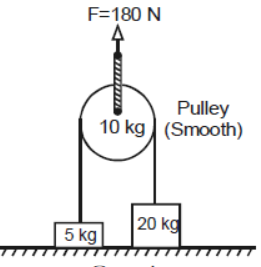
(a) 50 N
(b) 40 N
(c) 10 N
(d) Zero
Answer
B
Question. A block of mass 2 kg is kept on horizontal surface with coefficient of friction as indicated in figure. A horizontal time varying force F = (2 + t)N starts acting on the block at t = 0. Find the time after which the block begins to slide (g = 10 ms–2)

(a) 2 s
(b) 8 s
(c) 10 s
(d) 16 s
Answer
C
Question. A uniform rope of mass M and length L is hanging from the ceiling inside a lift going vertically upward with a constant acceleration a. The tension in the rope at a distance x (x < L) below its upper end is

Answer
B
Question. If in the given figure M1 = 1 kg; M2 = 2 kg; M3 = 3 kg, then

the acceleration of mass M2 will be
(a) 2 m/s2
(b) 1 m/s2
(c) 6 m/s2
(d) 3 m/s2
Answer
B
Question. Two masses M1 and M2 of mass 2 kg and 7 kg respectively attached to massless and frictionless pulleys with light string as shown. Tension in string will be
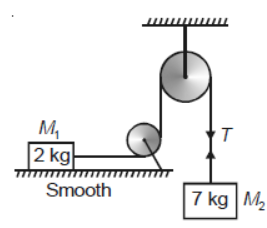
(a) 70/9 N
(b) 140/9 N
(c) 90/7 N
(d) 90/14 N
Answer
B
Question. A wedge and block having masses 10 kg and 2 kg respectively shown in figure. A force F is applied on the wedge towards left so that block falls freely. At time of falling, contact force between wedge and block is

(a) 2gcos30°
(b) 2gcos60°
(c) gsin30°
(d) Zero
Answer
D
Question. Accelerations of the blocks m1 and m2 in the given figure are (m1 = 5 Kg, m2 = 10 Kg)
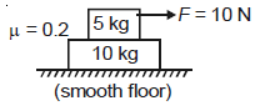
(a) 1 m/s2, 0
(b) 2 m/s2, 2/3 m/s2
(c) 2/3 m/s2 , 1 m/s2
(d) 2/3 m/s2, 2/3 m/s2
Answer
D
Question. Two masses m1 and m2 are connected by massless string as shown in figure. If both are moving in a circle with same angular speed and T1 and T2 are tensions in the strings, then
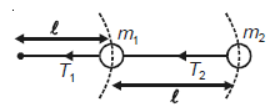
(a) T1 < T2
(b) T2 = T1
(c) T1 > T2
(d) T2 > T1 if m2 > m1
Answer
C
Question. Three masses M1, M2, M3 of masses 1 kg, 3 kg and 3 kg respectively are attached as shown in figure.
Correct relation between T, T1 and T2 is
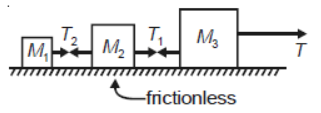
(a) T < T1 < T2
(b) T > T1 > T2
(c) T = T1 > T2
(d) T1 > T2 > T
Answer
B
Question. In given figure a body of mass 10 kg placed on a rough horizontal surface of coefficient friction of

If a horizontal force F = 10 N applied on it, then the value of acceleration of the body will be
(a) 1 m/s2
(b) 0.8 m/s2
(c) Zero
(d) 1.2 m/s2
Answer
C
Question. A block of mass 1 kg is placed on a rough horizontal surface. Find acceleration of body if horizontal force F = 10 N applied on it. (Initially block is at rest)

(a) 1 m/s2
(b) 8 m/s2
(c) Zero
(d) 1.2 m/s2
Answer
B
Question. If a nucleus of mass m eject an α – particle of mass m/59 with velocity u, then recoil speed of product nucleus is
(a) u/59
(b) 58u/59
(c) u/58
(d) 59u/58
Answer
C
Question. A bullet of mass 10 g fired by a gun at speed 150 m/s. It comes to rest in 0.01 s after collision with a wall, then average force applied by the wall on it is
(a) 15 N
(b) 30 N
(c) 150 N
(d) 1500 N
Answer
C
Question. Free body diagram of a block of mass m at rest on an unlevelled ground as shown in figure is
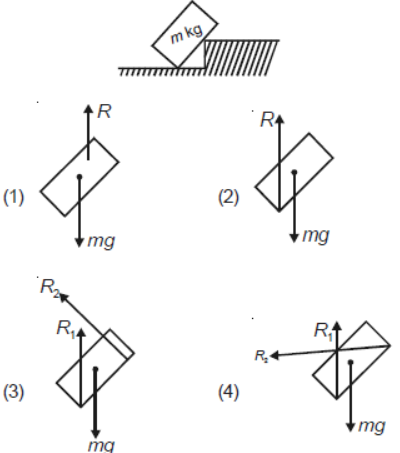
Answer
D
Question. A block of mass 10 kg is at rest on a rough surface coefficient of friction μ = 0.6, then downward acceleration of body is
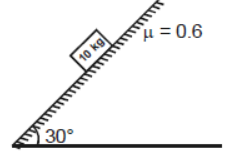
(a) gsin30°
(b) gcos30°
(c) g/sin30°
(d) Zero
Answer
D
Question. A block of mass m kg rest on a fixed rough wedge of inclination 60° having mass M kg. Then minimum value of coefficient of friction between block and wedge is
(a) mg/cos60
(b) gcot60°
(c) √3
(d) 1/√3
Answer
C
Question. Two block A & B are placed as in figure (mA < mB).
A force F acts on block A towards left. Friction force acting on B due to A block is in direction [μ is friction coefficient between A & B]

(a) Toward right
(b) Towards left A
(c) Towards up
(d) Towards down
Answer
B
Question. A car is accelerating horizontally with acceleration a towards left. A bob of mass m suspended from its roof by a string. The angle made by string from vertical at equilibrium is
(a) sec–1 (g/a)
(b) tan–1 (g/a)
(c) tan–1 (a/g)
(d) cot–1 (a/g)
Answer
C
Question. On a highway at a horizontal sharp turn of radius 20 m a sign board indicate that the maximum speed of vehicles will be 20 m/s. The minimum coefficient of friction between tyres of vehicle and road is
(a) 0.02
(b) 0.2
(c) 2
(d) 20
Answer
C
Question. A circular road of radius 40 m is banked at an angle of 45° with horizontal. The speed of vehicle on the road at which effect of friction neglected is
(a) 40 km/h
(b) 72 km/h
(c) 20 km/h
(d) 80 km/h
Answer
B
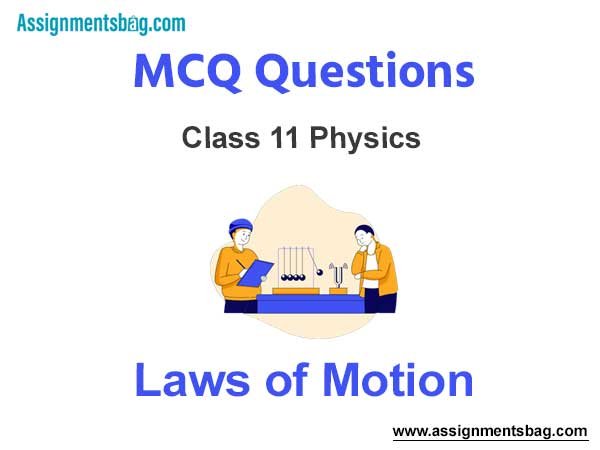
We hope you liked the above provided MCQ Questions Chapter 5 Laws of Motion Class 11 Physics with solutions. If you have any questions please ask us in the comments box below.

